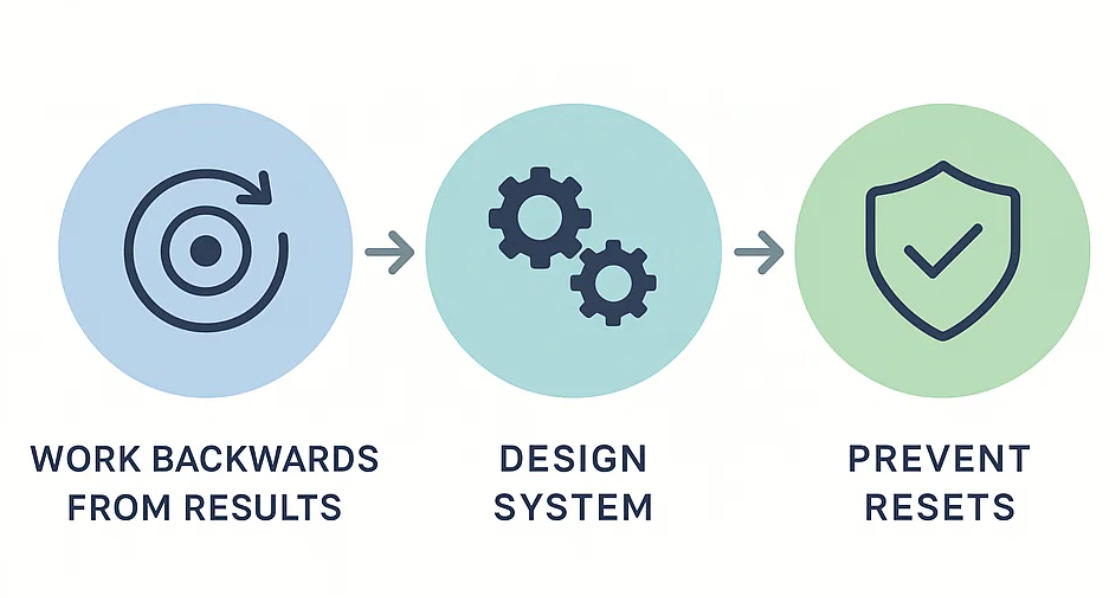First time here?
THE Different MBA is a weekly clarity rep for builders, product leaders, and founders.
Subscribe to build less, ship smarter, and win more → [Subscribe here]
I was there—technically.
I watched the rise of social media on college campuses. Facebook was exclusive, viral, and suddenly everywhere. People like Ryan Deiss were figuring it out in real time. They weren’t older than me. They just saw it differently—and they acted.
Meanwhile, I was doing everything “right”:
School. Credentials. The prescribed path.
But I wasn’t building leverage.
I was optimizing for someone else’s system.
Years later, I realized I’d been running on Factory Settings.
The California Breakthrough
“California is just different. It doesn’t work there. We’ve tried everything.”
That’s what I heard on Day 1 managing the California healthcare scheduling team.
They were stuck.
10–11 appointments/day when they needed 15+
Eighteen months of failure
The last manager quit
Leadership labeled it unsolvable
Even the team had internalized it:
“This is just how it is here.”
But what if the problem... wasn’t the problem?
The Factory Settings Trap
Everyone kept trying harder:
Work longer hours
Push the team
Double down on the Florida playbook
That’s Factory Settings thinking:
When something doesn’t work, do more of it.
The Florida protocols had worked—just not here.
And the harder they pushed, the more stuck they got.
Performance flatlined
Morale dropped
Turnover spiked
After 18 months? Same results. Worse team health.
The consensus: “California is impossible.”
But they weren’t dealing with bad people.
They were using the wrong system for a different reality.
The Moment Everything Shifted
I wasn’t smarter. I wasn’t more experienced. I just saw it differently.
Instead of asking:
“How do we make this work?”
I asked:
“What if we’re solving the wrong problem?”
And that changed everything.
This wasn’t formal methodology yet. I didn’t know Lean. Or Six Sigma.
I was just trying to make the work actually work—by thinking systematically.
Step 1: Work Backwards from Results
I started with the outcome:
“What would have to be true for this team to hit 15+ appointments/day?”
Working backwards, I uncovered the real constraints:
Physician-directed care (doctors steered referrals)
Health system control (in-network dominance)
Insurance dynamics (access required different coordination)
The insight:
We weren’t fighting lazy people or broken workflows.
We were applying Florida logic to California laws.
Step 2: Design the System to Walk Forward
Once I reframed the problem, we built a new system from the ground up.
New California Protocols:
Start by checking if the physician or health system directs care internally
Ask if treatment has already been started
Only then apply our standard Florida approach
Hiring Reset:
Recruited retail and restaurant pros—people used to:
Tough customers
High-pressure environments
Emotional labor
To them, call center work felt... manageable.
Partnership Strategy:
Used insurance company relationships to unlock hospital contracts we couldn’t reach alone
Step 3: Prevent Factory Resets
We didn’t just fix a local issue.
We built a system that would keep working—even after I left.
We documented:
California-specific protocols
Hiring profiles that thrived
Partnership strategies
Management training for scale
We turned a breakthrough into a repeatable model.
The Results: The Numbers That Changed Everything
Productivity:
10–11 → 15+ appointments per day
(Some schedulers hit 20+)
Retention:
3 months → 18 months (6× team stability)
Revenue:
Nearly doubled
Contracts:
10–12 new health system wins
Expansion:
California became the model for complex markets company-wide
The System Elevated People, Too
The same people we hired and trained?
One became our training manager
Another led operations after I moved on
Several got promoted to run other departments
We didn’t just improve performance.
We built momentum that elevated people.
The Universal Pattern I Discovered
This wasn’t a one-time fix.
It’s the same system I’ve used across teams, products, and industries for 15+ years.
The Engineering Momentum System™ – 3 Steps:
Work Backwards from Results
Design System to Walk Forward
Prevent Factory Resets
The 5PM Flywheel™ Framework:
Problem: Are we solving the right thing?
Prioritization: Are we betting on what matters?
Process: Are we building with focus?
Proof: Are we learning what works?
People: Are we aligned—or just reacting?
In California, momentum broke in:
Problem (wrong assumption: CA = FL)
Process (misaligned protocols)
People (misfit hiring profiles)
Once we fixed those? The system scaled.
The AI Disruption Reality
We’re now facing a similar pattern—at scale.
AI is eating frameworks. Memorization is a commodity.
Traditional MBAs train you to think like everyone else—just as thinking differently becomes your only edge.
The new defensible advantage?
Systematic decision-making under pressure.
Not more knowledge. Better momentum architecture.
THE Different MBA isn’t a school.
It’s a clarity-first operating system for ambitious builders, product leaders, and founders who:
Solve the wrong problems too often
Drown in frameworks that don’t flex
Want systems that scale without you
This isn’t about theory.
It’s about mastering the five parts of momentum:
✅ Solve the right problems
✅ Prioritize what matters
✅ Build with focus
✅ Learn what works
✅ Lead with alignment
No fluff. No gatekeeping. Just clarity, momentum, and real capability.
Why This Matters Now
AI doesn’t just speed things up.
It makes clarity the only edge that compounds.
We don’t need more MBAs.
We need mental operating systems that help people think clearly, act decisively, and lead under pressure.
That’s why I created THE Different MBA.
Ready To Apply Clarity-First Thinking?
The California breakthrough happened because I asked better questions before making decisions. The same systematic approach works for any high-stakes moment where clarity matters.
Before your next big meeting, sprint planning, or strategic decision:
Take 10 minutes with MyClaritySprint — the tool that helps you think through what actually matters before you walk into the room.
Work backwards from results. Surface your real assumptions. Get clear on what you're optimizing for.
👉 Start Here - Apply the same systematic thinking that turned around California.
Because the right questions prevent expensive mistakes.






